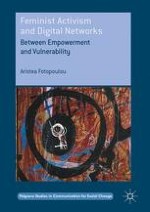2016 | OriginalPaper | Buchkapitel
5. Space, Locality and Connectivity: The End of Identity Politics as We Know It?
verfasst von : Aristea Fotopoulou
Erschienen in: Feminist Activism and Digital Networks
Verlag: Palgrave Macmillan UK
Aktivieren Sie unsere intelligente Suche, um passende Fachinhalte oder Patente zu finden.
Wählen Sie Textabschnitte aus um mit Künstlicher Intelligenz passenden Patente zu finden. powered by
Markieren Sie Textabschnitte, um KI-gestützt weitere passende Inhalte zu finden. powered by
